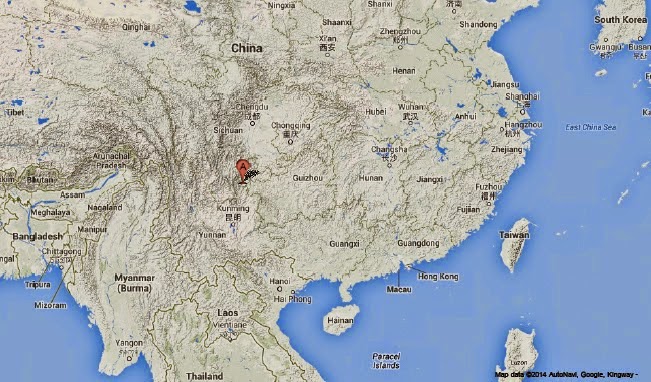The China Earthquake Networks Center recorded a Magnitude 6.6 Earthquake about 22 km to the west of the city of Weiyuan in Yunnan Province, China, slightly before 9.50 pm local time (slightly before 1.50 pm GMT) on Tuesday 7 October 2014. At least one person has been reported dead following the quake, with another 324 reported to have been injured, eight of them seriously. In addition buildings have been damaged across much of the region, and many people camped outside overnight out of fear of aftershocks.
Damage to buildings in Yongping in Yunnan Province following the 7 October 2014 Earthquake. AFP/Getty Images.
Much of western China and neighbouring areas of Central Asia and the
Himalayas, are prone to Earthquakes caused by the impact of the Indian
Plate into Eurasia from the south. The Indian Plate is moving northwards
at a rate of 5 cm per year, causing it to impact into Eurasia, which is
also moving northward, but only at a rate of 2 cm per year. When two
tectonic plates collide in this way and one or both are oceanic then one
will be subducted beneath the other (if one of the plates is
continental then the other will be subducted), but if both plates are
continental then subduction will not fully occur, but instead the plates
will crumple, leading to folding and uplift (and quite a lot of
Earthquakes). The collision of the Indian and Eurasian plates has lead
to the formation of the Himalayan Mountains, the Tibetan Plateau, and
the mountains of southwest China, Central Asia and the Hindu Kush.
See also...
 Magnitude 5.9 Earthquake in eastern Yunnan Province, China. The United States Geological Survey
recorded a Magnitude 5.9 Earthquake at a depth of 10 km in Yingjiang
County in eastern Yunnan Province, China, close to the border with
Myanmar, at about 9.20 am local time (about 1.20 am GMT) on Friday 30...
Magnitude 5.9 Earthquake in eastern Yunnan Province, China. The United States Geological Survey
recorded a Magnitude 5.9 Earthquake at a depth of 10 km in Yingjiang
County in eastern Yunnan Province, China, close to the border with
Myanmar, at about 9.20 am local time (about 1.20 am GMT) on Friday 30...
 Magnitude 4.6 Earthquake in northeast Yunnan Province, China. The United States Geological Survey
recorded a Magnitude 4.6 Earthquake at a depth of 29.9 km in Huize
County in the northeast of Yunnan Province, China, slightly after 11.35
pm...
Magnitude 4.6 Earthquake in northeast Yunnan Province, China. The United States Geological Survey
recorded a Magnitude 4.6 Earthquake at a depth of 29.9 km in Huize
County in the northeast of Yunnan Province, China, slightly after 11.35
pm...
Follow Sciency Thoughts on Facebook.
 Magnitude 5.9 Earthquake in eastern Yunnan Province, China. The United States Geological Survey
recorded a Magnitude 5.9 Earthquake at a depth of 10 km in Yingjiang
County in eastern Yunnan Province, China, close to the border with
Myanmar, at about 9.20 am local time (about 1.20 am GMT) on Friday 30...
Magnitude 5.9 Earthquake in eastern Yunnan Province, China. The United States Geological Survey
recorded a Magnitude 5.9 Earthquake at a depth of 10 km in Yingjiang
County in eastern Yunnan Province, China, close to the border with
Myanmar, at about 9.20 am local time (about 1.20 am GMT) on Friday 30...


